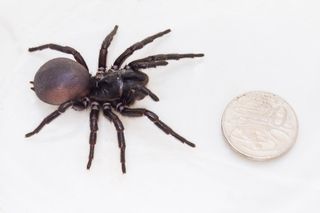Surprise! Newfound Venomous Spider Drops in on Scientists

Most people likely wouldn't react well to being surprised by a venomous spider, but recently, scientists at Booderee National Park, on the southern coast of Australia, were excited when a highly venomous funnel-web spider showed up unannounced.
Many species of funnel-web spiders, named for their funnel-shaped webs, are indigenous to Australia, but only one of these species, the Sydney funnel-web spider, is known to live in Booderee National Park.
Sydney funnel-webs (Atrax robustus) are ground-dwelling spiders with highly venomous bites that, before the development of an anti-venom, posed a serious medical risk to humans. Funnel-webs, including Atrax robustus, were believed to be responsible for at least 13 deaths in Australia before the anti-venom became available, in 1981. [Creepy, Crawly & Incredible: Photos of Spiders]
But the spider found along Australia's southern coast by scientists from the Australian National University (ANU) wasn't Atrax robustus. In fact, it might be a brand-new species of funnel-web spider, said Thomas Wallenius, a biologist at ANU's Research School of Biology and one of the scientists who uncovered the arachnid.
"It's remarkable that we have found this other species in Booderee National Park. It shows we still have a lot to learn about what's out there in the bush," Wallenius said in a statement.

The nearly 2-inch-long (50 millimeters) specimen is fairly large for a funnel-web spider, the researchers said. And unlike the Sydney funnel-web, this critter lives inside of fallen trees, not in underground burrows. This suggests that the newfound spider belongs to the genus Hadronyche, which consists of funnel-web spiders that are saproxylic, or dependent on dead or decaying wood for survival.
When Wallenius found the spider, it was burrowed in its "lair," a long web inside of a rotten log.
Sign up for the Live Science daily newsletter now
Get the world’s most fascinating discoveries delivered straight to your inbox.
"They build a silk-lined burrow inside the hollow log, which can be up to 2 meters [6.6 feet] long. She had probably been living in there for 25 to 30 years," Wallenius said.
That's right: Funnel-web spiders aren't just potentially deadly; they also live for an eerily long time. A study presented at the 22nd International Congress of Entomology in 2006 states that captive funnel-web spiders have a maximum life span of two decades.
The discovery of the (perhaps) previously unknown species of funnel-web spider comes on the heels of another exciting finding by ANU researchers. Last week, an ANU biologist discovered a rare, red-fanged funnel-web spider belonging to the species Atrax sutherlandi in Australia's Tallaganda State Forest. This area, like Booderee National Park, is located in the southeastern state of New South Wales.
ANU ecologist Mark Wong uncovered the red-tinted arachnid while searching for funnel-web spiders under a rotting piece of wood.
"Almost instantly, the spider had rushed out of her silken lair with her legs raised and fangs greeting me with glistening venom," Wong told Live Science in an email interview last week. "Taken aback by her colors, I knew there and then this was something special."
While some members of the A. sutherlandi species have a bit of red tint on their bodies, this was the first time Wong and his fellow researchers had observed a specimen with red fangs.
The discovery of both the blood-hued funnel-web spider and its cousin, the log-dwelling spider in Booderee National Park, are part of a large study of biodiversity in New South Wales. The state is also home to many species of peacock spiders, which are much less venomous than funnel-web spiders, and arguably a whole lot cuter (some of them even dance).
Follow Elizabeth Palermo @techEpalermo. Follow Live Science @livescience, Facebook & Google+. Original article on Live Science.

Elizabeth is a former Live Science associate editor and current director of audience development at the Chamber of Commerce. She graduated with a bachelor of arts degree from George Washington University. Elizabeth has traveled throughout the Americas, studying political systems and indigenous cultures and teaching English to students of all ages.
Most Popular

